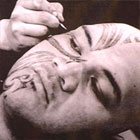Maori people have long been famous for having some of the world’s most spectacular tattoos. Traditional tattoos, or Mokos as they are called, are more than just body art to the Maoris. They are personal statements about themselves, their families, their history and their culture.
Moko Ink
Don visited Inia Taylor, an indigenous tattooist. Inia runs Moko Ink, an Auckland business specialising in Moko. He started studying Moko art 12 years ago, and has been tattooing the form for the past 10 years.
Inia constructed the Mokos in the film ‘Once Were Warriors’. Because the Moko is considered a very personal thing by Maoris, Inia made sure the film tattoos did not contain tribal affiliations and very little personal information. However, people were able to see how beautiful and visually uplifting traditional designs were, and this made Inia realise how important it is that the artform is revived in all its facets.
Traditional Maori Moko
Traditionally, Maoris tattooed their bodies to show others who they were. The tattoos showed family, tribe and status, and were worn by both men and women. ‘Ta Moko’ means the tattooing of the face or body in the traditional Maori way and has sacred connotations. More general tattooing is known as ‘Kirituhi’.
Tattoos were applied to the face and buttocks of men and to the chin, lips and shoulders of women. Depending on their rank, women sometimes had Ta Moko on their faces. The meaning of the Ta Moko varied depending on where it was on the face. The left side related to the father’s history and the right side to the mother’s history.
Tattoos were usually applied by priestly experts, who used albatross bones to chisel into the skin. They applied Carui Gum and other vegetable dyes, which were rendered into a soot and mixed with oils. Each tribal area used different pigments.
By the late 1800s Moko was in decline, then in 1907 the Tohunga Suppression Act made it illegal to wear or perform Moko. However, a revival of the artform began in the 1970s and 80s and continues today with young people once again adopting the Moko.
Further information
Our segment was filmed with:
Inia Taylor
Moko Ink
Auckland
Website: www.mokoink.com



